| |
Inflammatory Markers and Incident Fracture Risk in Older Men and Women: The Health Aging and Body Composition Study
|
| |
| |
Journal of Bone and Mineral Research, July 2007:22:1088-1095
Jane A Cauley, 1 Michelle E Danielson, 1 Robert M Boudreau, 1 Kimberly YZ Forrest, 2 Joseph M Zmuda, 1 Marco Pahor, 3 Frances A Tylavsky, 4 Steven R Cummings, 5 Tamara B Harris, 6 Anne B Newman, 1 for the Health ABC Study
1Department of Epidemiology, Graduate School of Public Health, University of Pittsburgh, Pittsburgh, Pennsylvania, USA;
2Department of Health and Safety, Slippery Rock University of Pennsylvania, Slippery Rock, Pennsylvania, USA;
3Department of Aging and Geriatric Research, Institute on Aging, University of Florida, Gainesville, Florida, USA;
4Department of Preventive Medicine, University of Tennessee, Memphis, Tennessee, USA;
5San Francisco Coordinating Center, CPMC, San Francisco, California, USA;
6Laboratory of Epidemiology, Demography, Biometry, National Institute on Aging, Bethesda, Maryland, USA.
Dr Cauley has received research support from Merck & Company, Eli Lilly & Company, Pfizer Pharmaceuticals, and Novartis Pharmaceuticals. She has also received consulting fees from Eli Lilly & Company and Novartis Pharmaceuticals. She is on the speaker's bureau for Merck and Company. All other authors state that they have no conflicts of interest.
".....in conclusion, higher levels of inflammatory markers were associated with an increased risk of fracture, We conclude that elevated inflammatory markers are prognostic for fractures, extending the inflammation hypothesis of aging to osteoporotic fractures.. The association was particularly strong for subjects who had elevations in two or three markers. Thus, our study supports the extension of the inflammation of aging hypothesis to include fractures. Elevations of inflammatory markers of aging may be a general marker of poor health and may identify subjects at high risk for fracture......The inflammation hypothesis of aging centers on the hypothesis that aging is the accumulation of damage, which results, in part, from chronic activitation of inflammation processes.....Cytokines also play major roles in bone remodeling, but the majority of this information has primarily come from in vitro and rodent studies
.......We conclude that elevated inflammatory markers are prognostic for fractures, extending the inflammation hypothesis of aging to osteoporotic fractures......The associations were particularly strong in persons who had more than one elevated marker: in the subset of 1418 subjects with data on all seven markers, there was almost a 3-fold increased risk of fracture in persons with three or more high inflammatory markers. It is unknown whether the inflammation response is a risk factor for fracture or an indicator of an underlying process that predisposes one to fracture......In our study, subjects with the highest CRP values (quartile 4, CRP ≥ 3.14 mg/liter) had a 37% increased risk of facture in the multivariate models. Several risk factors for fracture are associated with higher CRP levels including smoking, diabetes, physical activity, and high BMI. The addition of these factors in the model strengthened the association between CRP and fracture.....The finding of a strong link between IL-2 sR and fracture is new......we found high correlations between IL-2 sR and TNF sR1 and TNF sR2.(14) IL-2 sR has also been shown to be negatively correlated with 1,25(OH)2D and may be related to fracture because of an effect on the vitamin D regulatory system.......Subjects who fractured [in this study] were slightly older, had lower BMD, worse neuromuscular performance,and were more likely to smoke. The relative importance of each individual cytokine is difficult to assess. A composite measure of inflammation, combining information on CRP, IL-6, and TNFα in the whole population and also with the soluble receptors of IL-6, TNF, and IL-2, identified persons at a high risk of fracture. About 14% of subjects had three or more markers in the top quartile. These persons had a 2.7-fold increased risk of fracture; In the total population, persons with two or three "high" inflammatory markers had about 70% increased risk of fracture compared with those with no high levels (p trend for composite index = 0.035; Fig. 2A). These findings are consistent with previous work showing an increased cardiovascular risk(44) and disability risk(14) in persons with more than one elevated inflammatory marker.......Because of the complexity and interrelatedness of the many cytokines involved in the inflammation response, it is unlikely that a single biomarker would capture all of the important risk information."
ABSTRACT
The inflammation of aging hypothesis purports that aging is the accumulation of damage, which results, in part, from chronic activation of inflammation process. We tested this hypothesis in relationship to fractures in 2985 men and women enrolled in the Health ABC study. Results showed that subjects with the greatest number of inflammatory markers have the highest risk of fracture.
Introduction: Cytokines play major roles in regulating bone remodeling in the bone microenvironment, but their relationship to fractures is uncertain.
Materials and Methods: The study population includes 2985 well-functioning white and black women and men (42%, black; 51%, women) 70-79 yr of age enrolled in the Health Aging and Body Composition Study. Inflammatory markers were measured in frozen serum using standardized assays. We measured interleukin (IL-6), TNFα, C-reactive protein (CRP), and soluble receptors (IL-2 sR, IL-6 sR, TNF sR1and TNF sR2).Cytokine-soluble receptors were measured in a subset (n = 1430). Total hip BMD was measured by DXA. During 5.8 ± 1.6 yr of 95% complete follow-up, incident fractures were confirmed in 268 subjects. The risk of fracture was compared among subjects with the highest inflammatory markers (quartile 4) versus lower levels (quartiles 1, 2, and 3) using proportional hazard models.
Results and Conclusions: Subjects who fractured were more likely to be white and female. Baseline markers of inflammation were higher among subjects who subsequently experienced an incident fracture. In multivariate models, the relative risk of fracture (95% CIs) for subjects with the highest inflammatory markers (quartile 4) compared with those with lower inflammatory markers (quartiles 1, 2, and 3) was 1.34 (0.99, 1.82) for CRP; 1.28 (0.95-1.74) for IL-6; 1.28 (0.97-1.70) for TNFα; 1.52 (1.04-2.21) for IL-2 sR; 1.33 (0.90-1.96) for IL-6 sR; 1.73 (1.18-2.55) for TNF sR1 and 1.48 (1.01-2.20) for TNF sR2. In subjects with three or more (out of seven) high inflammatory markers, the relative risk of fracture was 2.65 (1.44-4.89) in comparison with subjects with no elevated markers. (p trend = 0.001). We conclude that elevated inflammatory markers are prognostic for fractures, extending the inflammation hypothesis of aging to osteoporotic fractures.
INTRODUCTION
The inflammation hypothesis of aging centers on the hypothesis that aging is the accumulation of damage, which results, in part, from chronic activitation of inflammation processes.(1) In other words, the organism trades short-term benefit for long-term damage. Circulating levels of pro-inflammatory cytokines are elevated in older subjects and have been linked to a number of conditions.(1,2) Specifically, interleukin (IL)-6 has been shown to predict overall mortality,(3) declines in both physical(4,5) and cognitive function,(6) dementia,(7) and activities of daily living (ADLs) disability.(4,5) Inflammatory markers are also strong independent risk factors for cardiovascular disease (CVD), including subclinical disease.(8) Of importance, an increased risk of CVD was found at levels previously thought to be in the normal range. Cytokines also play major roles in bone remodeling, but the majority of this information has primarily come from in vitro and rodent studies.(9) There is a paucity of research in humans, and to our knowledge, no study has addressed the inflammation hypothesis of aging with respect to fractures.
We used data from the Health Aging and Body Composition Study (Health ABC) to determine if circulating levels of C-reactive protein (CRP) and pro-inflammatory cytokines predict fractures in older men and women. We also tested the hypothesis that the number of high inflammatory markers is associated with an increased risk of fractures.
RESULTS
Over 5.8 yr of follow-up, 268 individuals suffered at least one incident fracture. A greater proportion of women and a lower proportion of blacks experienced a fracture (Table 1). Subjects who fractured were slightly older, had lower BMD, worse neuromuscular performance, and were more likely to smoke, to report lung disease, and to use osteoporosis medications and calcium and vitamin D supplements than individuals who did not fracture.
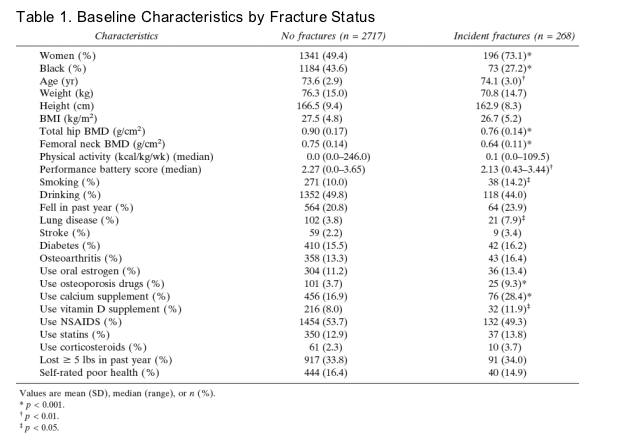
Markers of inflammation at entry to the study tended to be higher in subjects who experienced an incident fracture over follow-up (Table 2). Median levels of CRP, TNFα, IL-2 sR, IL-6 sR, and TNFα SRI and SRII were 6-12% higher among subjects who experienced an incident fracture in comparison with those who did not fracture. There was no significant difference in IL-6 between the two groups.
Table 2. Median (Range) of Cytokines by Incident Fracture Status
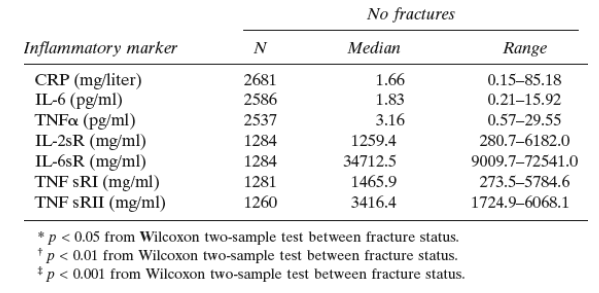
The incidence rate of fracture increased with increasing level of cytokine (Table 3). The incidence of fracture was almost 2-fold higher for subjects with the highest levels of TNFα, IL-2 sR, IL-6 sR, TNFα sRI, and TNFα sRII. The incidence of fracture was also highest in subjects with the highest CRP and IL-6, but the trend was not statistically significant.
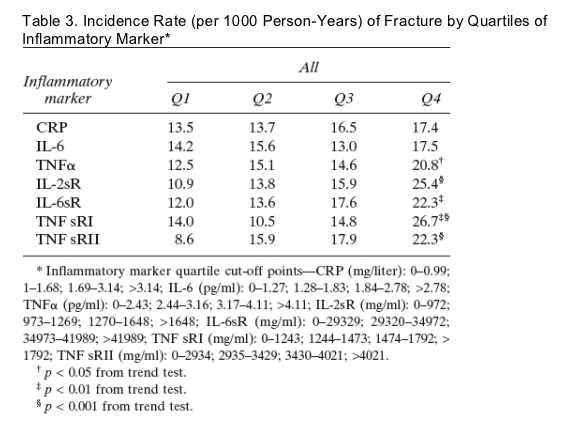
In proportional hazards models, the HR for fracture was greater for subjects with the highest cytokines (quartile 4) versus lower cytokines (quartiles 1, 2, and 3; Table 4). Subjects with the highest IL-6, TNFα, IL-2 sR, TNFα sR1, and TNFα sRII had a 27% to more than a 2-fold increased risk of fracture. Multivariate adjustment for other risk factors for fracture tended to attenuate the magnitude of the effect, but for the most part, the associations retained statistical significance.
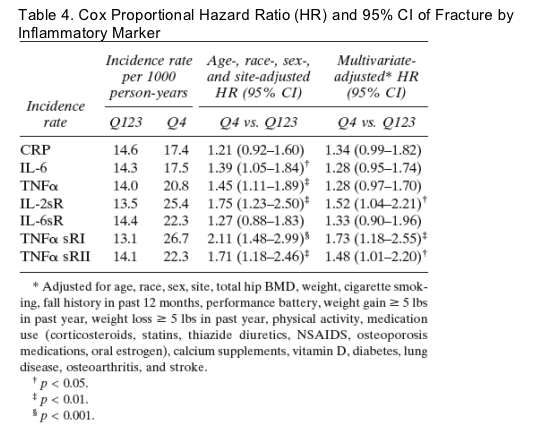
The risk of fracture was highest in individuals with two or more "high" levels (quartile 4) of inflammatory markers (Fig. 1). The Kaplan-Meier curves were significantly different between those with two or more "high" levels versus individuals with one or none (p = 0.0093). In the total population, persons with two or three "high" inflammatory markers had about 70% increased risk of fracture compared with those with no high levels (p trend for composite index = 0.035; Fig. 2A). In the subset of individuals with cytokine soluble receptor levels, the association was particularly strong. Subjects with three or more (of seven) "high" inflammatory marker levels had a 2.7-fold increased risk of fracture in comparison with those with no high levels (p trend for composite index = 0.001; Fig. 2B).
Figure 1 Cumulative percent with nonspine fracture by number of inflammatory markers in highest quartile of CRP, IL-6, and TNFα.
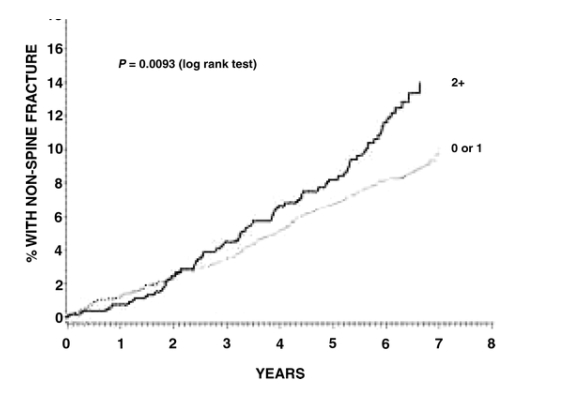
Figure 2 Hazard ratio (95% CIs) for fracture by the number of high inflammatory markers. (A) CRP, IL-6, or TNF-α: p value for the composite index; test for trend, p = 0.0035. (B) CRP, IL-6, TNF-α, IL-2sR, IL-6sR, TNFsR1, and TNFsR2: p value for the composite index; test for trend, p < 0.001. All models adjusted for age, race, site, sex, total hip BMD, height, weight, cigarette smoking, alcohol, fall history, weight gain ≥ 5 lbs in the past year, weight loss ≥ 5 lbs in the past year, performance battery, physical activity, medication use (corticosteroids, statins, NSAIDS, osteoporosis medications), calcium supplements, history of diabetes, lung disease, osteoarthritis, heart disease, and stroke.
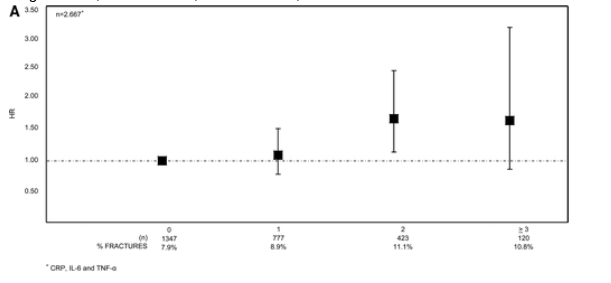
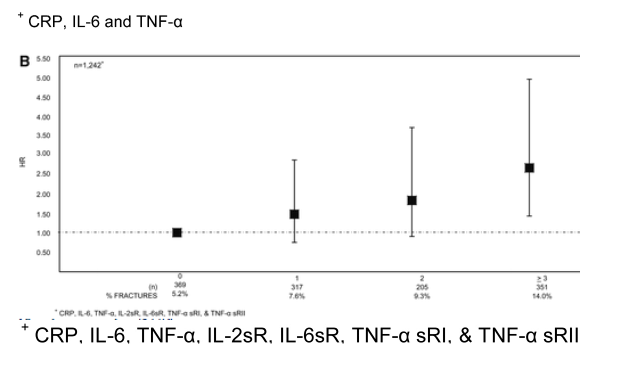
DISCUSSION
The study findings indicate that, in well-functioning older persons, high serum levels of inflammatory markers predicted a higher incidence of fractures during a 5.8-yr follow-up period. The associations were independent of physical frailty as assessed by physical performance, several chronic conditions that may place an individual at higher risk of fracture, weight loss, and medication use including NSAIDS and statins, which also decrease levels of inflammatory markers. The associations were particularly strong in persons who had more than one elevated marker: in the subset of 1418 subjects with data on all seven markers, there was almost a 3-fold increased risk of fracture in persons with three or more high inflammatory markers. It is unknown whether the inflammation response is a risk factor for fracture or an indicator of an underlying process that predisposes one to fracture.
There is increased recognition of the role of the immune system in the pathophysiology of osteoporosis.(15) Multiple cytokines and hormones seem to regulate both osteoclasts and osteoblasts, including their coupling, differentiation, and activity. Cytokines operate in a complex system that involves multiple cytokines, both pro-inflammatory and anti-inflammatory. The net balance between these two distinct systems plays important roles in the regulation of both osteoblasts and osteoblasts.(15)
In our study, we measured TNFα, IL-6, and IL-2. Most of the data that show that IL-6 and TNFα are involved in the pathogenesis of osteoporosis are based on animal studies,(16-19) although more recent studies have linked polymorphisms of IL-1, IL-6, and TNFα and their receptors to bone mass and fracture.(20-23)
TNFα is a pro-inflammatory cytokine that stimulates osteoclast bone resorption in vitro and in vivo,(24,25) possibly influencing bone resorption by increasing the formation of osteoclasts and early osteoclast precursors. The effect of TNFα on osteoblasts is less established, but recent studies have suggested that postmenopausally, follicle stimulating hormone stimulates TNF production, leading to increased formation of both osteoblasts and osteoclasts.(26) TNFα has been shown to activate osteoclasts through direct action, independent of and strongly synergistic with RANKL.(27) Estrogen deficiency results in a marked increase in pro-inflammatory cytokines including TNFα.(28) In our study, subjects with the highest level of TNFα had a 33% increased risk of fracture, independent of other risk factors.
Part of the difficulty in studying TNFα in the circulation is its short half-life. Increases in serum concentrations of TNFα are usually transient, whereas elevations of serum TNFα soluble receptors seem more constant.(29) Some evidence suggests that stimuli, which cause cytokine levels to rise, may also induce shedding of soluble cytokine receptors in an attempt to weaken the inflammatory response. Thus, elevated levels of soluble receptors may represent a more prolonged or severe underlying inflammatory state.(30,31) This may explain why the association between TNF seemed stronger for the soluble receptors. In addition, serial determination of TNF soluble receptor concentrations in healthy participants at 1-yr intervals showed little change in receptor concentration over time.(29) Hence, concentrations of the TNFα soluble receptors seem more stable and may be more reliable markers of chronic inflammation.
IL-6 is also a multifunctional cytokine that seems to have a number of effects on bone.(9,15) IL-6 is stimulated in response to PTH and other cytokines including TNFα and IL-1.(32) Subjects with the highest levels of IL-6 had a 39% greater risk of fracture. This association was slightly attenuated in our multivariate models and borderline significant. This attenuation suggests that at least some of the effect of IL-6 on fracture risk is indeed mediated by other factors included in the model, such as impaired physical function. IL-6 has previously been shown to predict incident mobility, limitations in Health ABC subjects(14) and other populations,(4) and increase the risk of muscle strength loss.(33)
IL-6 exerts its biological activity by binding to specific receptors; only a small fraction is free.(34) The IL-6 receptor consists of two subunits: (1) ligand binding soluble receptor and (2) a signal transducing receptor.(35) The soluble IL-6 receptor (IL-6 sR) may enhance the biological activity of IL-6. For example, in cell culture, IL-6 stimulated osteoclastgenesis only in the presence of IL-6 sR.(36) In transgenic mice, IL-6 sR acts as a binding protein, increasing the half-life of IL-6 and enhancing its biological activity.(36) Serum concentrations IL-6 sR levels were significantly higher in osteoporotic women, and there was an inverse correlation between IL-6 sR and lumbar spine BMD (r = 0.28).(35) In our study, the relationship between IL-6 sR and fracture was weaker than observed for other cytokines and not statistically significant. However, fracture rates were higher in these subjects, and failure to reach significance may have reflected the smaller sample size of individuals with measures of IL-6 sR.
CRP is the inflammatory marker that has been studied in the most detail, especially with respect to CVD. It is involved both in innate immunity and in the removal of necrotic and apoptotic cells.(37) It plays a central role in the acute phase response. Indeed, CRP levels have been reported to be increased among hospitalized fracture patients, reflecting the acute traumatic event.(38) CRP levels have been inversely correlated with BMD in community-dwelling women.(39) To our knowledge, there is limited information on whether CRP predicts fracture. In the Geelong Osteoporosis study, fracture risk was increased 24-32% for each SD increase in CRP.(40) This observation was independent of BMD, prevalent vertebral fractures, and bone turnover. Elevated risk of cardiovascular disease is typically observed among those with CRP values >3 mg/liter.(41) In our study, subjects with the highest CRP values (quartile 4, CRP ≥ 3.14 mg/liter) had a 37% increased risk of facture in the multivariate models. Several risk factors for fracture are associated with higher CRP levels including smoking, diabetes, physical activity, and high BMI. The addition of these factors in the model strengthened the association between CRP and fracture.
The finding of a strong link between IL-2 sR and fracture is new. High levels of IL-2 sR are correlated with increased T and B cell and immune systems activation.(42) The action of IL-2 sR on bone remodeling is unknown, but we found high correlations between IL-2 sR and TNF sR1 and TNF sR2.(14) IL-2 sR has also been shown to be negatively correlated with 1,25(OH)2D and may be related to fracture because of an effect on the vitamin D regulatory system.(15,43)
The relative importance of each individual cytokine is difficult to assess. A composite measure of inflammation, combining information on CRP, IL-6, and TNFα in the whole population and also with the soluble receptors of IL-6, TNF, and IL-2, identified persons at a high risk of fracture. About 14% of subjects had three or more markers in the top quartile. These persons had a 2.7-fold increased risk of fracture. These findings are consistent with previous work showing an increased cardiovascular risk(44) and disability risk(14) in persons with more than one elevated inflammatory marker. The use of this composite measure reduces misclassification leading perhaps to stronger relationships. Because of the complexity and interrelatedness of the many cytokines involved in the inflammation response, it is unlikely that a single biomarker would capture all of the important risk information.
Our study has a number of strengths. We examined multiple markers of inflammation in relationship to confirmed incident fractures, the most important clinical consequence of osteoporosis. Follow-up of the cohort was >95% complete. There were, however, several limitations. The soluble receptors were available on a random subset of individuals, and we had reduced power in this subset, but there was no evidence that fracture rates differed between those with and without soluble receptor levels. Our population was diverse, including men and women and blacks and whites. Most of the fractures occurred in white women and we had limited power to examine this association in separate ethnic and sex groups. In addition, our outcomes included all nontraumatic fractures, and we were unable to examine hip fractures specifically. We measured circulating cytokines in the serum but the highest concentrations of cytokines may be found in the bone microenvironment. Serum assays may not reflect local cytokine levels.
In conclusion, higher levels of inflammatory markers were associated with an increased risk of fracture. The association was particularly strong for subjects who had elevations in two or three markers. Thus, our study supports the extension of the inflammation of aging hypothesis to include fractures. Elevations of inflammatory markers of aging may be a general marker of poor health and may identify subjects at high risk for fracture.
ACKNOWLEDGMENTS
The Health, Aging and Body Composition (Health ABC) Study is supported by National Institutes of Health (NIH) funding, National Institute on Aging (NIA) contracts N01-AG-6-2101, N01-AG-6-2103, and N01-AG-6-2106. This research was supported in part by the Intramural Research Program of the NIH, National Institute on Aging.
MATERIALS AND METHODS
Study population
The Health ABC study is a prospective cohort study investigating changes in body composition as a common pathway by which multiple diseases contribute to disability. The study enrolled 3075 healthy men and women, 70-79 yr of age. A random sample of Medicare-eligible white individuals and all age-eligible black community residents were recruited from two clinical centers in the United States, Pittsburgh, PA, and Memphis, TN, using mass mailings with telephone follow-up in 1997-1998. Approximately 42% were black and 48.5% were men. Eligibility required that participants self-report the ability to walk 0.25 mi (400 m), climb a flight of stairs (10 steps), and perform basic activities of daily living without difficulty; to not have had a diagnosis of or be treated for a life-threatening cancer in the previous 3 years; and to reside within the study area for at least 3 years. The Institutional Review Boards at both clinical centers approved the study, and all participants gave informed consent.
Pro-inflammatory cytokines
Levels of IL-6, TNFα, high-sensitivity CRP, and the soluble receptors of IL-6 (IL-6 sR), IL-2 (IL-2 sR), and TNF (TNF sR1 and TNF sR2) were measured using stored serum collected at baseline. Serum levels of IL-6, TNFα, and CRP were measured on 2985 (97%) individuals in the cohort. Serum levels of soluble receptors were available on a random subcohort of 1418 (47%) individuals. Specimens were obtained by venipuncture in the morning after an overnight fast, processed, aliquoted into cryovials, frozen at -70��C, and subsequently shipped to the Health ABC Core Laboratory at the University of Vermont. Cytokines and soluble cytokine receptor levels were measured in duplicate using ELISA kits (R&D Systems, Minneapolis, MN, USA). The HS600 Quantikine kit was used to measure IL-6 with a detectable limit of 0.10 pg/ml. The HSTA50 kit was used to measure TNFα with a detectable limit of 0.18 pg/ml. The detectable limits for the IL-6 soluble receptor (using the DR600 kit), TNF soluble receptor I (using the DRT100 kit), TNF soluble receptor II (using the DRT200 kit), and the IL-2 soluble receptor (using the DR2A00 kit) were 6.5, 3, 1, and <10 pg/ml, respectively. Serum levels of high-sensitivity CRP were also measured in duplicate by ELISA based on purified protein and polyclonal anti-CRP antibodies (Calbiochem, San Diego, CA, USA). The CRP assay was standardized according to the World Health Organization's First International Reference Standard, with a sensitivity of 0.08 μg/ml. Reliability, as determined by blind duplicate analyses of IL-6, TNFα, and CRP, revealed average interassay coefficients of variation of 10.3%, 15.8%, and 8.0%, respectively. In older adults, levels of IL-6 and CRP measured at one point in time have been shown to be reliable, reproducible, and representative over extended periods of time.(10)
Incident fracture
Incident nontraumatic clinical fractures were assessed every 6 mo by self-report over a mean follow-up of 5.8 ± 1.6 yr. Follow-up of the cohort was >95% complete. All fractures were validated by radiology reports. Nontraumatic fractures were defined as those occurring spontaneously or from modest trauma (e.g., fall from a standing height or less). Medical record review was used to exclude fractures that were caused by excessive trauma (motor vehicle crash), a pathologic condition (e.g., cancer), or were of other/unknown cause.
Covariates
Demographic characteristics (age, sex, race/ethnicity), prevalent health conditions, self-rated health status, history of falls, medication use, weight change in the past 12 mo, and lifestyle behaviors (physical activity, smoking, alcohol consumption) were self-reported at baseline using an interviewer-administered questionnaire. Current medications were brought to the clinic and inventoried. Information was obtained on corticosteroids, statins, thiazide diuretics, nonsteroidal anti-inflammatory drugs (NSAIDS), estrogen, osteoporosis medications (bisphosphonates, calcitonin, and raloxifene), and calcium and vitamin D supplement use. All medication data were coded using the Iowa Information System ingredient codes.(11)
Height (cm) was measured twice without shoes using a Harpenden (Holtain) wall-mounted stadiometer. Weight was measured to the nearest 0.1 kg in light clothing on a standard, calibrated balance beam scale. Body mass index (BMI) was calculated as weight divided by the square of height (kg/m2).
Physical function was assessed using an adaptation of a performance-based score developed for the Established Populations for the Epidemiologic Studies of the Elderly (consisting of chair stands, standing balance, and a 6-m walk for gait speed). Physical function was assessed using an expanded self-report and performance-based measures of function developed for Health ABC that captures higher levels of functional ability over a broad range of functional capacity.(12) The Health ABC score includes self-reported function (difficulty/ease in walking, lifting, stooping, and standing up), performance-based measures, and 6-m walk. Health ABC performance score ranges from 0 to 4, with greater scores indicating better function.
BMD
BMD (g/cm2) of the hip (total and subregions) was measured using DXA (QDR 4500A; software version 9.03; Hologic, Bedford, MA, USA). DXA quality assurance procedures were conducted at both study sites and monitored by the study Coordinating Center, ensuring scanner reliability and identical scan protocols. An anthropometric spine phantom was scanned daily, and a hip phantom was scanned once per week to assess longitudinal performance of the scanners.
Statistical analyses
The characteristics of the subjects were compared by incident fracture status using t-tests for continuous variables and _2 tests for categorical variables. Several variables were not normally distributed (CRP, cytokines, physical activity, performance battery). Therefore, we used the Wilcoxon two-sample test to compare these variable by incident fracture (yes or no). We calculated the incidence of fracture (per 1000 person-years) by quartiles of inflammatory markers. Cox proportional hazards regression models determined the independent effect of the inflammatory marker on risk of fracture. Sex, race, and clinic site were forced into the model. We adjusted for risk factors for fracture including age, total hip BMD, weight, smoking, fall history in past 12 mo, weight gain ≥ 5lbs in past year, weight loss ≥ 5 lbs in past year, physical activity, medications (corticosteroids, statins, NSAIDS, osteoporosis medications, oral estrogen), calcium supplements, diabetes, lung disease, osteoarthritis, stroke, and performance battery score. Date of first fracture or last follow-up if no fracture occurred was used to censor data.
For the multivariate models, we dichotomized cytokines by comparing subjects with the lowest cytokines (quartiles 1, 2, and 3) and subjects with the highest cytokine level (quartile 4). Because high levels of two or more inflammatory markers likely represents a more specific indicator of systemic inflammation than a high level of just one inflammatory marker,(13,14) additional analyses were conducted with a composite inflammation index calculated as the number of inflammatory markers levels in the highest quartile. Kaplan-Meier curves were constructed to show the cumulative incidence of fracture comparing subjects with two or more "high" inflammatory markers with subjects with zero or one "high" inflammatory markers. The log-rank test was used to compare the two curves. We used a test for trend using Cox proportional hazards regression measuring the hazard ratio (HR) per unit increase when treating the composite index as a continuous variable.
REFERENCES
1. Tracy RP 2003 Emerging relationships of inflammation, cardiovascular disease and chronic diseases of aging. Int J Obes Relat Metab Disord 27(Suppl 3): S29- S34.
2. Tracy RP , Lemaitre RN , Psaty BM , Ives DG , Evans RW , Cushman M , Meilahn EN , Kuller LH 1997 Relationship of C-reactive protein to risk of cardiovascular disease in the elderly. Results from the Cardiovascular Health Study and the Rural Health Promotion Project. Arterioscler Thromb Vasc Biol 17: 1121- 1127.
3. Harris TB , Ferrucci L , Tracy RP , Corti MC , Wacholder S , Ettinger WH Jr , Heimovitz H , Cohen HJ , Wallace R 1999 Associations of elevated interleukin-6 and C-reactive protein levels with mortality in the elderly. Am J Med 106: 506- 512. [CrossRef]
4. Ferrucci L , Harris TB , Guralnik JM , Tracy RP , Corti MC , Cohen HJ , Penninx B , Pahor M , Wallace R , Havlik RJ 1999 Serum IL-6 level and the development of disability in older persons. J Am Geriatr Soc 47: 639- 646.
5. Ferrucci L , Guralnik JM 2003 Inflammation, hormones, and body composition at a crossroad. Am J Med 115: 501- 502.
6. Weaver JD , Huang MH , Albert M , Harris T , Rowe JW , Seeman TE 2002 Interleukin-6 and risk of cognitive decline: MacArthur studies of successful aging. Neurology 59: 371- 378.
7. McGeer PL , McGeer EG 2001 Inflammation, autotoxicity and Alzheimer disease. Neurobiol Aging 22: 799- 809.
8. Kritchevsky SB , Cesari M , Pahor M 2005 Inflammatory markers and cardiovascular health in older adults. Cardiovasc Res 66: 265- 275.
9. Mundy GR , Oyajobi B , Trajanedas K , Dallas S , Chen D 2001 Cytokines and Bone Remodeling in Osteoporosis, 2nd ed. Academic Press, San Diego, CA, USA.
10. Macy EM , Hayes TE , Tracy RP 1997 Variability in the measurement of C-reactive protein in healthy subjects: Implications for reference intervals and epidemiological applications. Clin Chem 43: 52- 58.
11. Pahor M , Chrischilles EA , Guralnik JM , Brown SL , Wallace RB , Carbonin P 1994 Drug data coding and analysis in epidemiologic studies. Eur J Epidemiol 10: 405- 411.
12. Simonsick EM , Newman AB , Nevitt MC , Kritchevsky SB , Ferrucci L , Guralnik JM , Harris T 2001 Measuring higher level physical function in well-functioning older adults: Expanding familiar approaches in the Health ABC study. J Gerontol A Biol Sci Med Sci 56: M644- M649.
13. Penninx BW , Geerlings SW , Deeg DJ , van Eijk JT , van Tilburg W , Beekman AT 1999 Minor and major depression and the risk of death in older persons. Arch Gen Psychiatry 56: 889- 895.
14. Penninx BW , Kritchevsky SB , Newman AB , Nicklas BJ , Simonsick EM , Rubin S , Nevitt M , Visser M , Harris T , Pahor M 2004 Inflammatory markers and incident mobility limitation in the elderly. J Am Geriatr Soc 52: 1105- 1113.
15. Clowes JA , Riggs BL , Khosla S 2005 The role of the immune system in the pathophysiology of osteoporosis. Immunol Rev 208: 207- 227.
16. Kimble RB , Matayoshi AB , Vannice JL , Kung VT , Williams C , Pacifici R 1995 Simultaneous block of interleukin-1 and tumor necrosis factor is required to completely prevent bone loss in the early postovariectomy period. Endocrinology 136: 3054- 3061.
17. Weitzmann MN , Cenci S , Rifas L , Haug J , Dipersio J , Pacifici R 2001 T cell activation induces human osteoclast formation via receptor activator of nuclear factor kappaB ligand-dependent and -independent mechanisms. J Bone Miner Res 16: 328- 337.
18. Kawaguchi H , Pilbeam CC , Vargas SJ , Morse EE , Lorenzo JA , Raisz LG 1995 Ovariectomy enhances and estrogen replacement inhibits the activity of bone marrow factors that stimulate prostaglandin production in cultured mouse calvariae. J Clin Invest 96: 539- 548.
19. Ammann P , Rizzoli R , Bonjour JP , Bourrin S , Meyer JM , Vassalli P , Garcia I 1997 Transgenic mice expressing soluble tumor necrosis factor-receptor are protected against bone loss caused by estrogen deficiency. J Clin Invest 99: 1699- 1703. [CrossRef]
20. Tasker PN , Albagha OM , Masson CB , Reid DM , Ralston SH 2004 Association between TNFRSF1B polymorphisms and bone mineral density, bone loss and fracture. Osteoporos Int 15: 903- 908.
21. Chung HW , Seo JS , Hur SE , Kim HL , Kim JY , Jung JH , Kim LH , Park BL , Shin HD 2003 Association of interleukin-6 promoter variant with bone mineral density in pre-menopausal women. J Hum Genet 48: 243- 248.
22. Ferrari SL , Karasik D , Liu J , Karamohamed S , Herbert AG , Cupples LA , Kiel DP 2004 Interactions of interleukin-6 promoter polymorphisms with dietary and lifestyle factors and their association with bone mass in men and women from the Framingham Osteoporosis Study. J Bone Miner Res 19: 552- 559.
23. Moffett SP , Zmuda JM , Oakley JI , Beck TJ , Cauley JA , Stone KL , Lui LY , Ensrud KE , Hillier TA , Hochberg MC , Morin P , Peltz G , Greene D , Cummings SR 2005 Tumor necrosis factor-alpha polymorphism, bone strength phenotypes, and the risk of fracture in older women. J Clin Endocrinol Metab 90: 3491- 3497.
24. Bertolini DR , Nedwin GE , Bringman TS , Smith DD , Mundy GR 1986 Stimulation of bone resorption and inhibition of bone formation in vitro by human tumour necrosis factors. Nature 319: 516- 518.
25. Johnson RA , Boyce BF , Mundy GR , Roodman GD 1989 Tumors producing human tumor necrosis factor induced hypercalcemia and osteoclastic bone resorption in nude mice. Endocrinology 124: 1424- 1427.
26. Iqbal J , Sun L , Kumar TR , Blair HC , Zaidi M 2006 Follicle-stimulating hormone stimulates TNF production from immune cells to enhance osteoblast and osteoclast formation. Proc Natl Acad Sci USA 103: 14925- 14930.
27. Fuller K , Murphy C , Kirstein B , Fox SW , Chambers TJ 2002 TNFalpha potently activates osteoclasts, through a direct action independent of and strongly synergistic with RANKL. Endocrinology 143: 1108- 1118.
28. Riggs BL , Khosla S , Melton LJ III 2002 Sex steroids and the construction and conservation of the adult skeleton. Endocr Rev 23: 279- 302.
29. Aderka D , Engelmann H , Shemer-Avni Y , Hornik V , Galil A , Sarov B , Wallach D 1992 Variation in serum levels of the soluble TNF receptors among healthy individuals. Lymphokine Cytokine Res 11: 157- 159.
30. Van Zee KJ , Kohno T , Fischer E , Rock CS , Moldawer LL , Lowry SF 1992 Tumor necrosis factor soluble receptors circulate during experimental and clinical inflammation and can protect against excessive tumor necrosis factor alpha in vitro and in vivo. Proc Natl Acad Sci USA 89: 4845- 4849.
31. Honda M , Yamamoto S , Cheng M , Yasukawa K , Suzuki H , Saito T , Osugi Y , Tokunaga T , Kishimoto T 1992 Human soluble IL-6 receptor: Its detection and enhanced release by HIV infection. J Immunol 148: 2175- 2180.
32. Jilka RL 1998 Cytokines, bone remodeling, and estrogen deficiency: A 1998 update. Bone 23: 75- 81.
33. Schaap LA , Pluijm SM , Deeg DJ , Visser M 2006 Inflammatory markers and loss of muscle mass (sarcopenia) and strength. Am J Med 119: e9- e17.
34. Sehgal PB 1996 Interleukin-6-type cytokines in vivo: Regulated bioavailability. Proc Soc Exp Biol Med 213: 238- 247.
35. Giuliani N , Sansoni P , Girasole G , Vescovini R , Passeri G , Passeri M , Pedrazzoni M 2001 Serum interleukin-6, soluble interleukin-6 receptor and soluble gp130 exhibit different patterns of age- and menopause-related changes. Exp Gerontol 36: 547- 557.
36. Tamura T , Udagawa N , Takahashi N , Miyaura C , Tanaka S , Yamada Y , Koishihara Y , Ohsugi Y , Kumaki K , Taga T , Kishimoto T , Suda T 1993 Soluble interleukin-6 receptor triggers osteoclast formation by interleukin 6. Proc Natl Acad Sci USA 90: 11924- 11928.
37. Mold C , Gewurz H , Du Clos TW 1999 Regulation of complement activation by C-reactive protein. Immunopharmacology 42: 23- 30.
38. Lumbers M , New SA , Gibson S , Murphy MC 2001 Nutritional status in elderly female hip fracture patients: Comparison with an age-matched home living group attending day centres. Br J Nutr 85: 733- 740.
39. Ganesan K , Teklehaimanot S , Tran TH , Asuncion M , Norris K 2005 Relationship of C-reactive protein and bone mineral density in community-dwelling elderly females. J Natl Med Assoc 97: 329- 333.
40. Pasco JA , Kotowicz MA , Henry MJ , Nicholson GC , Spilsbury HJ , Box JD , Schneider HG 2006 High-sensitivity C-reactive protein and fracture risk in elderly women. JAMA 296: 1353- 1355.
41. Pearson TA , Mensah GA , Alexander RW , Anderson JL , Cannon RO III , Criqui M , Fadl YY , Fortmann SP , Hong Y , Myers GL , Rifai N , Smith SC Jr , Taubert K , Tracy RP , Vinicor F 2003 Markers of inflammation and cardiovascular disease: Application to clinical and public health practice: A statement for healthcare professionals from the Centers for Disease Control and Prevention and the American Heart Association. Circulation 107: 499- 511.
42. Rubin LA , Nelson DL 1990 The soluble interleukin-2 receptor: Biology, function, and clinical application. Ann Intern Med 113: 619- 627.
43. Oelzner P , Franke S , Muller A , Hein G , Stein G 1999 Relationship between soluble markers of immune activation and bone turnover in post-menopausal women with rheumatoid arthritis. Rheumatology (Oxford) 38: 841- 847.
44. Cesari M , Penninx BW , Newman AB , Kritchevsky SB , Nicklas BJ , Sutton-Tyrrell K , Rubin SM , Ding J , Simonsick EM , Harris TB , Pahor M 2003 Inflammatory markers and onset of cardiovascular events: Results from the Health ABC study. Circulation 108: 2317- 2322.
|
|
| |
| |
|
|
|